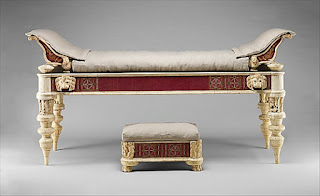Nowadays,
going to bed is a simple task; people go to sleep in their own, warm bed,
usually in their own room. However, during the Middle Ages, things were very
different. Only the wealthy (nobles) could afford to have their own bed in a
separate room. These beds were extremely expensive and often mentioned in wills. Peasants had houses without internal walls, so there was only
one large room in the house, with a single bed that was shared by family
members and eventual guests. The reason
for having a single bed in the house was that beds were really expensive. While
nobles had beds with mattresses, sheets, canopies and curtains, peasants could
only afford straw mattresses and animal skin to cover themselves.
In medieval
times, beds were more than a place to sleep, they served a social function as well.
They were a gathering place, the whole family slept in the same bed, and
guests were often invited to sleep in the same bed. A famous example is when
Richard I of England shared his bed with Philip II of France. This was a
diplomatic action, a demonstration of trust between the two nations. Nobles would also receive guests and have meetings while in bed.
Even though they were important and expensive, beds were quite dirty. Lice, fleas and bed bugs were common. Even most nobles didn't change their bed sheets with frequency. Peasants also had to share their bed with rats, since there were no walls to separate the house in different rooms and they had poor sanitary conditions. Single beds with private rooms only became common during the past couple of centuries.
Beds varied according to different civilizations, and they evolved throughout the ages:
Even though they were important and expensive, beds were quite dirty. Lice, fleas and bed bugs were common. Even most nobles didn't change their bed sheets with frequency. Peasants also had to share their bed with rats, since there were no walls to separate the house in different rooms and they had poor sanitary conditions. Single beds with private rooms only became common during the past couple of centuries.
Beds varied according to different civilizations, and they evolved throughout the ages:
Egyptian bed
Roman bed
Henry VIII's bed at Hever Castle
The Great Bed of Ware built in 1580
Polish style bed of the 18th century
Napoleon I's bed at Château de Compiègne








No comments:
Post a Comment